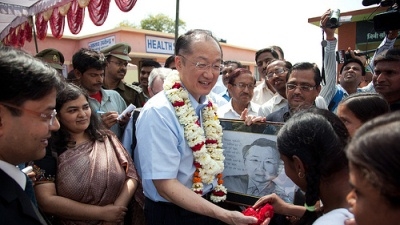On an early afternoon in a quiet village in Uttar Pradesh – India’s most populous state, and also one of its poorest – World Bank Group President Jim Yong Kim experienced the challenges an emerging India faces in meeting the soaring aspirations of its people and reducing poverty.
The magnitude is formidable – if Uttar Pradesh were a country, it would be the fifth-largest in the world. And his visit was memorable: crowds greeted him at every stop, including one neighborhood in which women rained flowers on his head.
Over several hours, Kim visited the village of Tilsari Khurd to see a child care center and village health center; traveled to a neighborhood in Kanpur, where he walked around an urban settlement; and then went to the banks of the Ganges (Ganga) River, where he saw a drainage system that pours human waste into the sacred waterway.
In Tilsari Khurd (population 3,791) past a patchwork of ripening winter wheat, Kim sat down with a group of preschool children at an early childhood care center. When one little girl was asked what she liked best about coming here, she promptly replied that it was the “khichri” – the hot porridge of rice and dal (lentils) that is given to the children every day to boost their nutrition under a national program.
At the village health center, Kim met women paramedics who provide pre- and post-natal care to pregnant and lactating women and new mothers. Providing health care to scattered villages is particularly a challenge for Uttar Pradesh, where more than three-fourths of the population live in the countryside, women bear more children than in other states, and rates of infant and maternal mortality are among India’s highest. Nevertheless, a cash-transfer scheme that encourages deliveries at health facilities is having an impact, and “all village children have been immunized against common childhood diseases, including measles, and polio,” a nurse-midwife told Kim.


